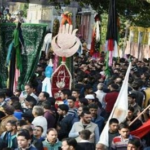
Delhi-Noida Border, National Capital Region
In a distressing turn of events, the otherwise bustling route from Delhi to Noida turned into a nightmarish ordeal for hundreds of commuters as a result of a massive traffic jam triggered by the incessant drizzle that persisted throughout the evening. The deluge of rain brought trouble in its wake, causing a gridlock that stretched for nearly three kilometers near the Delhi-Noida border, leaving commuters stranded for hours.
As evening descended upon the National Capital Region, the roads became clogged with a sea of vehicles, their headlights casting a glaring glow against the backdrop of the darkened skies. Honking sounds filled the air, echoing the growing frustration of drivers and passengers alike, as they grappled with the grueling situation on the roads.
The Noida-Delhi Kalindi Kunj border, usually a route characterized by swift travel, became a sluggish crawl for the unfortunate motorists caught in the snarl. What used to be a mere five-minute journey across the Yamuna bridge morphed into a tiresome half-hour ordeal, underscoring the severity of the traffic jam.
The traffic police, facing an uphill battle in managing the chaotic situation, attributed the jam to the peak hour congestion, exacerbating the already challenging conditions caused by the persistent rain. With vehicles inching forward at a snail’s pace, commuters found themselves trapped in their own metal cages, their frustration mounting as time ticked away.
Visuals of the traffic jam painted a grim picture of the extent of the problem, with rows upon rows of immobile cars forming a line that seemed endless. The rain-drenched roads offered no respite, further aggravating the predicament for those hoping for a swift commute home or to their destinations.
As the situation unfolded, efforts to clear the traffic and restore normalcy were underway. However, the scale of the jam and the weather conditions made the task an uphill battle for the authorities.
Commuters took to social media to vent their frustration and share their experiences, hoping for a resolution to the impasse. Many appealed to fellow commuters to stay patient and calm amidst the trying circumstances, recognizing that a collective effort was needed to navigate the challenging traffic situation.
As the night wore on, commuters remained hopeful for a breakthrough that would bring an end to their nightmarish ordeal. The incident served as a stark reminder of the vulnerability of urban infrastructure in the face of adverse weather conditions and peak hour congestion.
For now, the rain-induced gridlock at the Delhi-Noida border continues to be a significant challenge for both commuters and authorities, underscoring the need for improved traffic management systems and contingency plans during unfavorable weather conditions.





